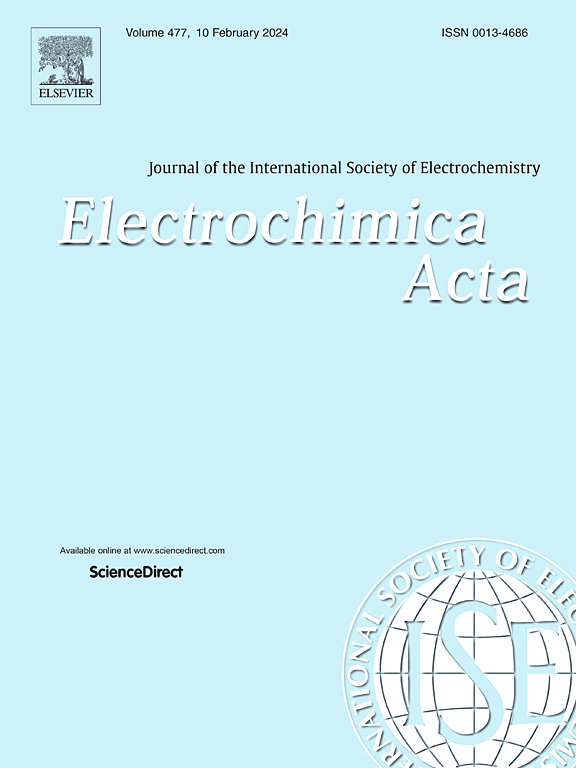Conductive matrix architecture of sulfate-reducing bacteria boosts coculture electrical output
IF 5.6
3区 材料科学
Q1 ELECTROCHEMISTRY
引用次数: 0
Abstract
Biogenic iron sulfide nanoparticles (FeS NPs) synthesized by sulfate-reducing bacteria (SRB) are prevalent in anoxic environments. The role these electrically conductive FeS NPs play in microbial interactions, however, remains undefined. We showed interactions between current producing microbes where Desulfovibrio vulgaris Hildenborough, a SRB, utilized FeS NPs to form long-range electron pathways in collaboration with Shewanella oneidensis MR-1, an iron-reducing bacteria. Single-potential amperometry showed synergetic current production associated with biogenic metallic FeS NPs with coculture of D. vulgaris and S. oneidensis compared to pure cultures. The synergetic current production in the coculture was diminished in the absence of biogenic FeS or with a mutant strain of S. oneidensis lacking genes encoding the electron transport pathway of the MtrCAB protein complex. Fluorescent in situ hybridization revealed the formation of cell-NP agglomerations that were twice as thick in cocultures as those from pure cultures, and the cell number of D. vulgaris was enhanced in the presence of S. oneidensis. Cell-NP agglomerations over 15 µm gap source–drain electrodes showed long-range current conduction in the coculture bioagglomerates specifically in the presence of metallic FeS. Additionally, nanoscale secondary ion mass spectroscopy revealed 15N and 13C assimilation, indicating sustained microbial metabolic activity in the cell-NP agglomerations. These data suggest that long-range electric conduction via biogenic FeS NPs enables SRB to cooperate with metabolically compatible partners, potentially activating the anaerobic SRB respiration that drives the global carbon and biogeochemical sulfur cycles.


硫酸盐还原菌的导电基质结构提高共培养电输出
由硫酸盐还原菌(SRB)合成的生物源硫化铁纳米颗粒(FeS NPs)在缺氧环境中普遍存在。然而,这些导电的FeS NPs在微生物相互作用中的作用仍未明确。我们展示了产生电流的微生物之间的相互作用,其中Desulfovibrio vulgaris Hildenborough (SRB)利用FeS NPs与舍瓦氏菌(Shewanella oneidensis) mr1(一种铁还原细菌)合作形成远程电子路径。单电位安培法显示,与纯培养相比,金针菊和金针菊共培养可产生生物源金属FeS NPs。在缺乏生物源性FeS或缺乏编码MtrCAB蛋白复合物电子传递途径的突变株的情况下,共培养中的协同电流产生减少。荧光原位杂交结果显示,共培养形成的细胞- np团块厚度是纯培养的两倍,并且在单株存在的情况下,D. vulgaris的细胞数量增加。在共培养的生物团块中,特别是在金属FeS存在的情况下,在15µm间隙的源-漏极上的细胞- np团块显示出远距离电流传导。此外,纳米级次级离子质谱显示15N和13C同化,表明细胞- np聚集中持续的微生物代谢活动。这些数据表明,通过生物源FeS NPs的远距离电传导使SRB能够与代谢相容的伙伴合作,潜在地激活厌氧SRB呼吸,从而驱动全球碳和生物地球化学硫循环。
本文章由计算机程序翻译,如有差异,请以英文原文为准。
求助全文
约1分钟内获得全文
求助全文
来源期刊

Electrochimica Acta
工程技术-电化学
CiteScore
11.30
自引率
6.10%
发文量
1634
审稿时长
41 days
期刊介绍:
Electrochimica Acta is an international journal. It is intended for the publication of both original work and reviews in the field of electrochemistry. Electrochemistry should be interpreted to mean any of the research fields covered by the Divisions of the International Society of Electrochemistry listed below, as well as emerging scientific domains covered by ISE New Topics Committee.
 求助内容:
求助内容: 应助结果提醒方式:
应助结果提醒方式:


